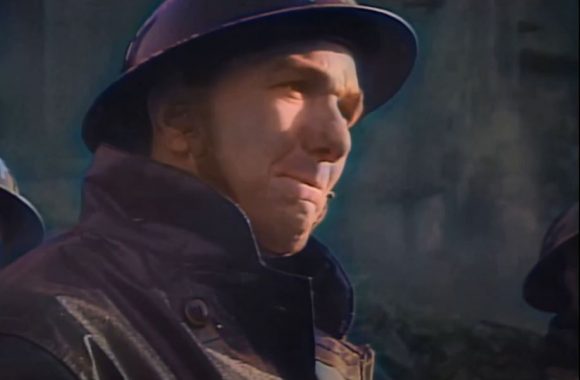
Author: pete@coventryrebuilt.com

Rex Cinema
Gone with the Wind…
The Rex cinema, built in 1937, it was one of the most sophisticated cinemas in the UK. Sadly it only lasted 3 years 6 months and 17 days before it was completely destroyed in World War II. The night before it was due to show “Gone with the Wind
1935 Planning & Design
Mr H.T. A. Philpot makes an announcement at a social gathering in December 1935 of his intention to build a new Cinema in Coventry that will include a café and snack bar. Coventry Corporation sold the land at the recently completed Corporation Street for £17,250 on condition that a cinema and shops will be completed within 18 months.
Restaurant – clean modern lines, soft indirect lighting, a tropical bird aviary and mirrors. The restaurant will be terraced in the style of gay continental clubs.
Snack Bar – a frieze of caricatures of famous film stars sprayed onto the wall.
Auditorium – warm soft pastel shades of red with metallic finishes. Large vertical coves and square panels that will light the main ceiling. Curtain – gold fire proof satin.
Entrance Hall – will be brilliantly lit with soft red and gold. The pay boxes stocked with chocolate and tobacco kiosks. The large foyer will provide for both the stalls and balcony so there will be no external queuing in bad weather.
1936 Construction
July – Building work began. Students from the Technical college visit the building site to admire the new modern pile driving method to ensure perfect foundations. First-time piles of this type to a depth of 18 ft were used in Coventry.
Apparently – During foundation works – a large masse of old foundations, huge quantities of soft black mud and a huge amount of water ingress. Large masses of horns of cattle bones and what appeared to be blood were encounter. It was suggested at the time by Mr J B Shelton (enthusiastic antiquarian) the site was once the site of the Bablake pool. If more excavations were made he suggested an old mill may have been encountered. During foundation works at the wine lodge, corner of corporation street, an ancient paddle was found. It was also suggested the large mass of cattle bones may have been from a period when the animal herds were slaughter on mass due to a plague.
Injury! Workmen injured on site – John Kirby (28) treated for a cut to head and shock. Henry Bunker (60) cut to the face and injury to the leg. And again, Dec 36 – Ambulance called for William Deacon suffering a cut to the head after a mallet fell on him!
Cinema Particulars
Cinema designed by Robert Cromie, with Mr Montague Marvin acoustic expert ensured perfect acoustics. Seating Capacity for 2,562 (500 in the circle, 2062 in the stalls). Total cost £150,000 £6,000 on furniture, decoration and kitchen equipment. Restaurant seating capacity 200, snack bar 100. Between 9th Feb – 28th Feb 1937 663 lunches, 1,218 teas, 1,039 dinners averaging 150 meals per day.
450 / 500 Tons of steel costing £12,000. Cantilevered girder for the balcony: 98 feet long, 8ft 6 inches wide, weighing 46 tons, cost £1,150 and £110 to transport it from Glasgow. 113 Piles were sunk for the foundation. The steel frame encased in brick with white reconstituted Portland Stone with a cavity ensuring the cinema is sound and damp proof.
Long window 56 feet overlooking Corporation Street. Kitchen to be ultra modern and fitted with all gas appliances – A large Regulo controlled range with the new solid top and four ovens.
Opening Night Programme
500 guests of the management – enough to fill the circle, stalls to be opened to the public on a first come first served basis.
Mayor [A.H. Barnacle] opened the cinema, congratulated the Philpot Brothers for a wonderful building which would undoubtedly help popularise corporation street. He added, the street had been subject to much criticism, but would be given a new start with the Rex, before long the street would gain popularity and importance of Corporation Streets in other cities.
The Mayor remarked – during his youth the great fair was the only principle source of amusement. Colonel W.F. Wyley, added – I recall a time when Coventry had only one small theatre – in Vicar Lane. [This memory would go back to about 1880 and his memory would be of the Empire Palace which stood near, what is now, Barracks Car Park]
Congratulatory telegrams came from W.F. Strickland M.P. (who couldn’t attend), Mr Lupino Lane, Mr & Mrs George Formby, Mr Basil Dean etc.
Mr Billy Milton (British Film Star), Miss June Duprez, the former Coventry Repertory company actress who is now enjoying screen success were introduced to the audience. M’lle Vanda Greville, the French film actress was also in attendance but was to shy to come on to the stage.
The programme included – God save the king, Coventry Mayor Speech, British Movietone News, Bottles (cartoon), Interlude – Wurlitzer Organ, Feature Film – San Francisco (about the 1906 earthquake, 30 years previous, likely many of the guest would have read the news first hand).
Wurlitzer Organ – only one in Coventry
Mr Reginald Dixon was at the helm (but some reports that he was ill that night and Arthur Aikman stood in..)– he closed his performance with an extremely ‘hot’ version of Tiger Rag. Reginald Dixon was booked for 4 days. Harry Farmer was to follow.
Many guests danced on the stage to music by the Hippodrome Orchestra under the direction of Mr. W. Pethers who composed a piece especially for the night.
Projectionists – George Smith and Eddie Wileman
1937
February –
16th 8pm, only a week after the cinema had opened a power cut caused the cinema to close early. All 2,200 customers were given commentary tickets.
2,500 school children from across Warwickshire attend a Robert Mayer series of concerts for Children.
18th – Mirrophonic sound reproduction to be installed in the Rex after many transatlantic cables with the American company. The Rex is to be the first cinema in Europe to be fitted with the sound system. It was hoped this would have been ready for the opening night, sadly it proved to be impossible to obtain the system in time.
Thanks to the new Di-phonic horn system everything recorded on the soundtrack of the film, every variation in pitch and volume, is evenly distributed throughout the auditorium, preventing ‘dud spots’. The system adds a quiet beauty, even the rustling of a dress is fully auditable with the Mirrophonic sound.
At a trade show in London where the system was demonstrated, an audience of cinema professionals who had calmly sat through showings of San Francisco in their own theatres using conventional sound systems were fetched from their seats during the terrifying sounds conveyed during the earthquake sequence.
The Rex Cinema Coventry will be a ‘show house’ for the sound system. Hundreds of important people in the cinema industry from Great Britain, and indeed, Europe will travel to Coventry to hear our cinema sing aloud.
March –
George Formby makes a personal appearance at the Rex during an afternoon performance, whilst he is performing at the Theatre Royal Birmingham in “Dick Whittington”.
Cinema applies to the council for a licence to sell intoxicating liquor – summary of some of the comments:
Any person dining at the Rex, who would like to take whisky or beer with his meal has to send out for it. The drink has to be carried through the streets when it rains it is unfortunate the drinks are watered down. It would be impossible to carry cocktails from the nearest licenced premises without spilling them. Mr R. Oxley of the Queens Hotel objected to the licence. He said, he had visited the Rex Cinema, but not the restaurant, however, he had heard birds whistling overhead.
Mr Ferraro oversaw the catering at the Rex. He had previously worked at Ciro’s London and 12 trips on the Queen Mary. During the licensing hearing, it was asked – “Has the manager found that the Rex, unlike the Queen Mary, will not run on water?”
After a long hearing, the Coventry Licensing Justice decided to grant a licence for the consumption of intoxicating liquor with meals for a term of 3 ¼ years. NO vertical drinking to be permitted.
Plans made to combine the snack bar with the Rex banqueting hall next door. A small snack bar (that looks more like a cocktail bar) was to be installed in the restaurant.
May –
200 cinema electricians and projectionists from across the Midlands are invited to a special look around and lunch at the restaurant.
Royal heritage film to be shown every day during the week of the coronation. Any Boy, of any age, with the name REX will be given two free seats upon the presentation of their birth certificate.
1937
November – Famous American Visit – Mr Spyras Skouras who owns over 800 cinemas in America was on holiday in England.
He made a special visit to Coventry to see the Rex cinema after it was recommended to him as one of the best provincial cinemas. Mr Skouras had visited several London cinemas and had been bitterly disappointed.
However, he was obviously delighted with the Rex cinema, Coventry. He commented upon the skilful design of the cinema, he said the restaurant was the best he had seen associated with a cinema outside of America.
1939
Fire in the neighbouring shops – papers fall into the electric fire. Fire brigade quick put it out, no major damage.
The Coventry branch of the Electrical Association for Women met at the Rex Cinema.
1940
January – Air Defence Cadet Corps Appeal: The sum of £78 has been raised by the appeal made at the Rex Cinema last week for funds to provide greatcoats, boots and other equipment for members of the No. 8 F (Frederick Bird) squadron of the Air Defence Cadet Corps, Coventry.
Through the co-operation of Mr H. T. A. Philpot and the management of the cinema the appeal was made by various speakers, each night prior to the showing of the air film “The lion has wings”.
The squadron expresses appreciation of the generous response of the public and states that the total contributed includes a donation of 10 guineas from No. 5 Group Centre of the Observer Corps.
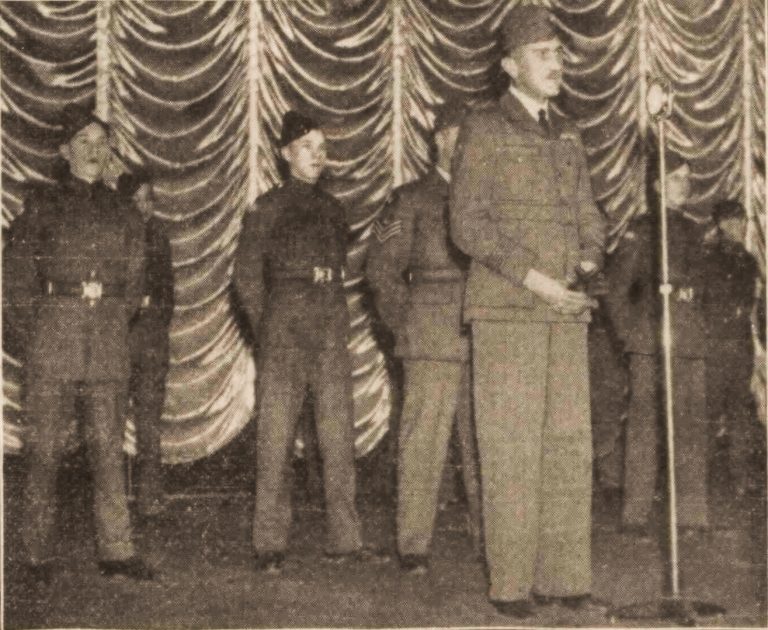
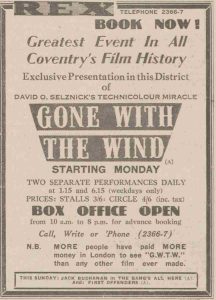
1940
25th August – Direct hit by a high explosive bomb lands on the circle blowing the cinema apart.
The frontage and restaurant survive. Local paper – just a single line saying it’s out of the listing. The Avery in the restaurant was damaged but some of the birds were found to be still on their perches.
The nearby West Orchard Church & West Orchard Congregational Sunday School led the Easter parade just before the war. A large colourful banner was used in in the precession. After the bombing, it was found floating tattered in the breeze on the debris of the Rex Cinema.
Reports of bombing in/around 2nd November / early October? another hit destroys the cinema, nothing is left this time.
Later stories were reported in the 1970s – Eddie Wileman projectionist went to the cinema on Monday Morning to get ready for the showing of Gone with the wind – Corporation Street was fenced off and the Rex had gone with a blast.
1942
19th March – Two cases of theft of lead the property ministry of supply from sites in Coventry came before the Coventry magistrates yesterday. In one case, the theft of lead from the site of the Rex cinema corporation street was alleged against two Birmingham men – Arthur Percy Griffin, 69 and Thomas Leo Leathem. Detective Coleman said Leathem was employed as a labourer salvaging material from the Rex site, and the other man was a lorry driver moving the material. The two men took the lead to a metal merchant and received £1 17s. 6d. Leathem told the Bench that he had a fit of temper and took the metal. Griffin said other drivers had had orders not to take it, but he himself had not had any such order.
Each man was fined £3 and Leathem was ordered to pay £1 7s and Griffin 10s. 6d costs.
June 14th – Coventry people heard the sound of an explosion on Sunday Morning. The façade of the Rex Cinema was blown up by a charge, the south side of Corporation Street had to be closed temporarily.
1943
September 26th – Battle of Britain Parade Sunday Programme: A great combined parade, representative of all services will take place at Coventry. The Mayor (Mrs Emily Smith) will take the salute accompanied by a group Captain A. G. Miller and Brigadier A. Smith.
The parade will march in column of threes, and the head will pass the saluting base on the site of the “Rex Cinema” in Corporation Street at 3 pm.
1951
Council committee objects to a market opening on the site of the former Rex Cinema. The objection was based not on the increase of competition, but to the fact that a new market site, distant from others was proposed. It was felt that this helped to removed opportunities for comparison of traders offers by the shopping public.
1952
April – Army Apprentices Mobile Exhibition: The famous queen mary trailer, complete with scale models of tanks, guns and modern army equipment made by boys of the army apprentice schools will be open to the public at the Rex Cinema Site Saturday 26th April 10 am – 6 pm. Free Admission
August – Sea Scots to exhibit canoes and other sea scouting equipment on the former Rex Cinema site Corporation Street for a one-day event.
December – Coventry Men’s Morris and sword dancing club augmented by a team from Birmingham will perfume at 2:30 pm on the bombed site (old Rex Cinema).
1953
West Orchard Market to transfer to the Rex Cinema site to make way for the new Owen Owen store and the new hotel as part of the Broadgate Redevelopment.
October 9th – Market opens on the site of the Rex Cinema – Grand opening of the Rex Market at 10.30 Friday 9th October 1953 by the Lord Mayor of Coventry. Managed by Mr Leslie Walker Special displays of materials, dresses art ware, fancy and leather goods, chinaware, laces, ladies & Gentlemen’s wear, shoes, hardware, jewellery, books, novels, animal foods, pet shop, toys, confectionery, fresh fruit and vegetables, flowers, plants, light refreshments, ices, children’s roundabout. It’s a market well worth visiting.
1954
Public notice – Coventry council give public notice of compulsory order to buy the land.
1960
Coventry Council compulsory purchase the Rex Buildings Corporation Street at a cost of £82,475 as part of the Smithford Way redevelopment plan which include a 13 storey tower block.
1962
Workmen building an entrance to the new multi-storey car park on Corporation Street unearthed tons of iron girders which were the old foundations of the cinema. These girders are to be torn out before the new roadway is finished. All that was the Rex Cinema has now gone, but some of the Rex complex, the shops (next door to the cinema) still remain, known as Fortress House.
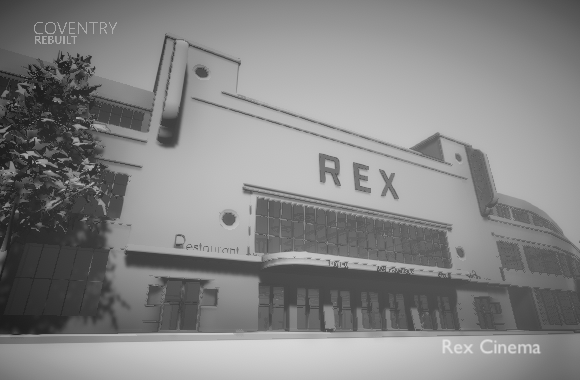
Owen Owen
After the demolition of Butcher Row in 1935 [the oldest part of Coventry dating back 700 years], the Liverpool based Owen Owen department store planned a new venture in Coventry.
After several delays, the store opened 11an 17th September 1937 to coincide with the opening of Trinity Street. Employing over 400 staff, the store sold almost everything. Like many of Coventry’s 1930s grand designs, it was completely destroyed on the 14th November 1940.
Owen Owen Ltd and their associated company J. P. Hughes Ltd possess two large stores in Liverpool, which have now reached a stage of demanding further developments. Coventry with its population of 200,000 and a further 100,000 in towns immediately adjacent was considered large enough to support a store of this statue, the first venture for the company outside of Liverpool.
Owen Owen Ltd a family-owned business was originally founded in 1868 and caters in the main for the family with incomes of between £200 and £600 a year [Today’s money £10,000 – £30,000]
1936 September 14th– Appointments now being taken for Hairdressing and Beauty Culture – Please phone Coventry 5566
Grand Opening 1937
17th September 11 am
Opening Ceremony by the Mayor Alderman A.H. Barnacle at Broadgate Entrance to coinciding with the Opening of Trinity Street. A huge crowd gathers – Women who were unable to get a glimpse of the ceremony used the makeup mirrors from their handbags as periscopes.
Mayor Barnacle
“People should now dispel forever the old bogey of Coventry’s Backwardness it was now their duty of the citizens of Coventry to spend their money in the city. The citizens of Coventry had a direct interest in the Company’s prosperity inasmuch as the Corporation was the owner of the site.
When the lease of 99 years ended, he hoped the history of the store will have been such that the Corporation of 2036 would have no hesitation in granting a renewal of the lease. To Messrs Owen Owen and to all tradesman in the city the Mayor said he wished good luck and prosperity in the developments that so obviously lie ahead in Coventry.”
Presented with a gold key, he unlocks the doors. The Mayoress was presented with a bouquet of flowers and then they tour the store and were the first to sign the visitor’s book.
Soon after the doors opened and mainly women who hoped to be among the first customers rushed in.
March 1938
Mechanical man Monsieur Patou visits for three weeks!
Don’t fail to see his demonstrations, they’re mysterious, baffling! See if you can answer the question that everyone in Coventry will be asking:
Is he man or machine?
Coventry shoppers rubbed their eyes in amazement yesterday afternoon when a car pulled up outside Messrs Owen Owen Store in Broadgate and from it a alighted a man wearing a silk topper, silver-knobbed cane and immaculate evening coat.
But it was not so much the manner in which he was attired as the way in which he walked from the car to the main doors of the store that made the people stare. His gait was of no ordinary human being but more than anything it resembled that of some mechanical man. Actually, they were witnessing the arrival of Monsieur Patou the mechanical man.
Monsieur Patou will demonstrate in the store every day at 11:30 and 3:00. With a show of Magic in the second-floor restaurant at 4:30.

1938 December – Sanforized-shrunk shirting measuring 129ft was hung on the front of the store for 7 days and 7 nights. It was then washed 7 times by the London laundry to show its non-shrinking qualities.
IT DID NOT SHRINK
A FRACTION OF AN INCH!
1939 November
350 Women Wardens needed but only 60 have so far enrolled. The primary objective of the wardens is to keep the populace calm during the course of an air raid. The supervisor, Miss Betty Winslow said –
“Homely sort of women is what we want. They must be level headed, in fact, the sort of women the neighbours would run to if they were in trouble at any time.”
Applicants must be between 35 and 50 years of age. When an air raid warning sounds they would be allocated to the shelters in the city centre, which include those at Owen Owen, British Home Stores, Smarts, Mills and Mills the Cathedral crypt and others in Cox Street, White Friars Street, Bishop Street, Bayley Lane, West Orchard, High Street, Hay Lane, Much Park Street, Broadgate, the Market Hall Cellars and at the Gas and Electricity Showrooms in Corporation Street.
Enrol at Owen Owen today!
1940 February Injury – Thomas Donnelly (28) walked into a plate glass window at Messrs Owen Owen on Wednesday night during the blackout. He cut his head and was taken to the hospital.
1940
15th October – Owen Owen suffers bomb damage
16th October Will all staff please report at the staff entrance tomorrow (Thursday 17th October) in the following order
Café – 9:30 am, Ground Floor Staff 10.00am Lower Ground Floor and First Floor 10.30am Office and Service Staff 11.00am.
17th October – Owen Owen are proud to announce that owing to the loyalty and industry of their staff, they are able to open the store tomorrow, Friday at 2.30 pm.
1940 – 14th November: Last Advert of Owen Owen…
November 19th – Owen Owen (Coventry) Ltd NOTICE TO ALL STAFF – All instructions to staff will be published through the columns of this paper. A staff office to deal with queries will be opened in the city as soon as possible. All wage clerks are asked to report to Miss Arthwison, Linden House, 4 Spencer Road Coventry.
November 21st – Notice to all staff – Temporary offices have been opened at 2 Queen’s Road Coventry. All staff are asked to call there on Friday or Saturday next for their wages and further instructions. If possible please call at the following times – Selling Staff: Friday from 10 am to 1 pm, Café Staff Friday 2 pm to 4 pm Non-Selling Staff Saturday 10 am – 1 pm.
November 26th – Owen Owen wishes to announce that they will shortly Reopen in smaller premise on the opposite side of Trinity Street –
The opening date will be announced later.
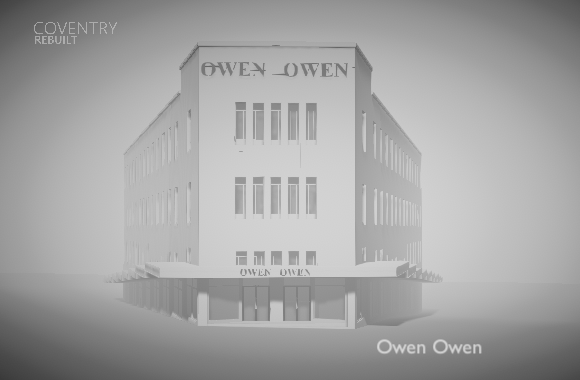
St Mary’s Cathedral
St Mary’s Cathedral (Cathedral No. 1)
This is a short potted history of Coventry’s first Cathedral – much of its history has sadly been lost. I’m in no way a historical expert so apologies if this isn’t completely correct.
8th Century
St Osburga abbess of a nunnery that stood on the site.
1016
Nunnery destroyed by Danish raiders.
1034
4th October dedication of the church and abbey of St Mary’s.
12th Century
The pre-existing monastery – The Benedictine Priory of St Mary’s was transformed into a Cathedral.
16th Century
Henry VIII.. the Reformation came and with it the dissolution of the Monasteries. Coventry Cathedral fate was uncertain.
1040s (ish)
Around this time the church became a Cathedral – becoming the Bishopric of Coventry and Litchfield.
1057
Leofric dies – buried in the abbey church.
1067
Lady Godiva dies – buried in the abbey church [the crypt of both Lady Godiva and Leofric is rumoured to still lie underground]
1143
monks were kicked out by Robert Marmion who fortified the Priory and laid siege to the nearby castle.
1189
Monks kicked out again and their lodgings demolished by Bishop Hugh de Nonant.
1198
Monks allowed to return.
1220
Impressive West Front added. The Bishop of the Bishopric of Coventry and Litchfield preferred spending time in Litchfield. Apparently, the monks of Coventry were always arguing – Litchfield monks were much better behaved.
14th Century
Black death and plague.
1539
15th January – Only 13 Benedictine monks were kicked due to the reformation. Having one Bishopric with two Cathedrals was an issue – they had a choice of which one to save.
The mayor, the Aldermen and the Bishop of Coventry and Litchfield tried to save the cathedral.. in vain. The money could not be raised by the local community to save the Cathedral.
500 years of historic documents destroyed.
1545(ish)
Demolition of the Cathedral and Priory began. John Hales (is this where Hales Street is named after?) bought the site for £1,000 and demolished it.
1714
Blue Coats School founded in the ruins of the cathedrals northwest tower.
Bits of the Cathedral remained up to the 1800’s – slowly decaying and demolished bit by bit.
Stone from the Cathedral can be found all over the city – when the Coventry Arms was demolished cathedral stone was found beneath.
When Owen Owen as built in the 1930’s the quarry for the stone that built the cathedral was found.

Sources –
Coventry’s First Cathedral – The Cathedral and Priory of St Mary: George Demidowicz
Coventry Cathedral Time Team – available on youtube : https://www.youtube.com/watch?v=vVuqwzgOUrk
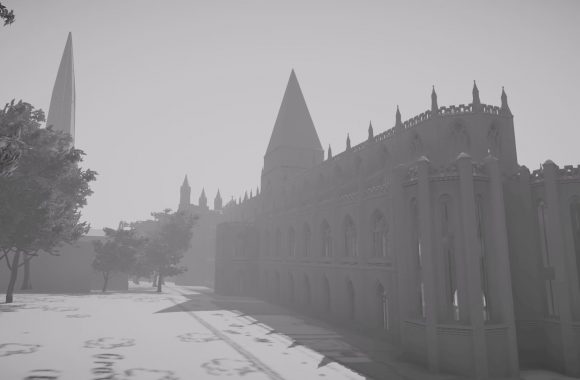
Coventry Market
The Coventry Market Hall was built in the 1860s, complete with a clock tower. It became the beating heart of the city until its destruction in 1940.
1719 – The ‘old’ Market Hall was a relatively small structure situated to the West of Broadgate, between West Orchards and Smithford Street. Built in the yard of the Peacock’s Inn, in 1719. It was known by some as Solomon’s Temple – apparently named after one of the custodians of the Market building. However important this market building was, the main market was the open air market in Broadgate.
1854 – Coventry Corporation considers the idea of a new Market Hall.
1860 – Land on Holyhead Road sold off by the Corporation to fund the New Market Hall.
1863 – Alderman H Soden –
“The state of Broadgate on Market Days was a disgrace to the city – positively uncivilised!
It had been decided some time ago that the crockery dealers should be restricted to Market Street and the fish sellers to another part.
But lately the crockery dealers have found their way back to the centre of the town and are making a great nuisance of themselves!”
20th August – Queen Victoria gives Royal Assent to the building of the Coventry Market Hall via the Coventry Market Hall Act 1863
1864 – The Corporation reports the cost is between £5,000 – £10,000 for the buildings, about £6,000 for the land but that excludes the property already owned by the Corporation. The Clerk then reports a figure of £25,000 to £30,000 for the whole project. [Sounds like he was making it up on the spot!].
1865 – January An exhibition at St Mary’s Hall of several designs, each comprising of 7-8 drawings. They were all well received by the Corporation and the people of Coventry.
However, the winning design was modified by the Corporation to allow for a Crystal Palace style roof from the second best design. The site chosen will remove a number of old buildings that a strange to the city would hardly believe could exist in the centre of a respectable old place like Coventry.
The primary entrance to the Market Hall will be from West Orchards that will include a row of high-quality shops. The second entrance will be via Market Street. The entrance from Broadgate will be widened with the removal of the City Arms Inn. In all, this will be a marked improvement and benefit to public sanitation.
The ornamental tower, adapted from the fixing of a clock was taken from the winning design was not to be erected immediately due to cost. It may, however, be added with advantage at a future period when the town is more prosperous. It has been proposed that a time ball might be added to its extreme summit instead of the customary wind vane – the watchmakers of the city would see this as a great advantage to be in immediate communication with Greenwich.
September – A suggestion of a ceremony and dinner to mark the laying of the foundation stone was put forward. The motion was not carried and so, never too place.
Contract awarded to Mr W Tomlinson of Coundon – Between 1865 and 1867 the demolition and building work takes place.
Grand Opening
Wednesday 19th June 1867
The Coventry and Midland Manufacturing, Industrial and Art Exhibition
Local Societies & Associations are invited to take part in a procession on the opening day.
Notice to exhibitors – no goods will be received after 10th June.
Season tickets (including admission on the opening day) will be ready on and after Monday next.
They will be on sale at the Herald Office & Corn Exchange – Adults 15s, Children 7s 6d.
Exhibition includes –
Two enormous lumps of Coal from Wyken Colliery – each weighing up to two Tons will be standing against the exits.
Numerous models of buildings.
Interesting displays of natural products of minerals and fossils.
A quantity of old armour and guns from Coombe Abbey.
300 Pictures on loan from the Earl of Craven, Earl of Dudley, Earl of Warwick, Lord Leigh, Mr Bromley MP, Mr Wise MP and some treaures from Dr Dewes and Mr Gulson. Rev J W Leigh has provided a selection of water colour drawings. Mr Eaton MP specimens of Alhambra decoration taken from the Alhambra Palace.
Ancient Corporation records will be arranged in cases down the centre.
Valuable assortment of antiquities from Lichfield museum will be on display.
The celebrated Kenilworth Buffett of carved oak will be on display, which formed an attractive object in the great exhibition of 1851 and was afterwards purchased by the inhabitants of Warwick and presented by them to the Earl of Warwick on his marriage. [ The buffet has not moved from Warwick Castle – click here ]
Every Day – the fair fountain will be flowing, pipping Bullfinches & Machinery in Motion, Doors open at 10 o’clock and close at dusk.
The Exhibition will be open every Saturday afternoon after 2pm for the WORKING CLASS at six pence each.
[To the musical profession – a gentlemen required to act as organist and pianist at the Coventry Exhibition, also six instrumentalists for the quadrille band – apply at the market hall]
Dignitaries
- Right Honourable Lord Leigh
- Lord Lieutenant of Warwickshire
- The Right Honourable the Earl of Clarendon
- K.G. James Marriott
- Esq Mayor of Coventry
- The Right Rev. the Lord Bishop of Worcester
- The Right Honourable Lord Lyttelton
- Lord Lieutenant of Worcester
- The Right Honourable the Earl of Aylesford
- The Right Honourable Earl Howe
- The Mayors of Tamworth, Lichfield, Nottingham, Derby and Stratford, Captain Adams
- Rev. J.H.Iles (Wolverhampton)
- Rev. R.H. Baynes (Coventry)
- Rev. S.H Wilddrington
- Rev. Dr Temple, Rev. A.W. Wilson (Coventry)
- Rev. E.E. Delf (Coventry)
1867 –
July – Shilling days – Monday, Tuesdays Wednesdays, Thursdays, Fridays and Saturdays. Half Crown Days – Thursdays. Children Half Price, Season Tickets down to 10s.
August – ‘Everyone should read Mrs Brown’s Trip to the Exhibition at Coventry priced at two pence published by Mr W. Fred of Taunton’.
Exhibition Prize Medal – The committee of the Coventry Exhibition hereby offer a prize of £5 for the best design for a medal to be given o the successful exhibitors.
1st November – Starnurer Howkin – DRUNK and DISORDERLY! in Market Street – The prisoner pleaded guilty and expressed his regret for the offence. The bench discharged him with a fine of 2s 6d in the poor box.
20th November – The letting of Market Hall Shops and pitches will start at 12 o’clock promptly. The sale of ale, porter, wines or spirits will not be permitted in any part of the market hall.
2nd December – Market Traders OUTRAGE! They are now paying four times the rents they did in Broadgate. They make a request o the Mayor and Aldermen that they can trade each of the first five evenings of the month until 8 pm with the use of free gas light.
Saturday 30th November 1867
Last Open Air Market in Broadgate
Under the Coventry Market Hall Act 1863 – Any person other than a licensed hawker, who sell’s or exposes for sale in any pace in this city expect his own dwelling place or shop will be liable to be a penalty not exceeding forty shillings.
This will come into effect on Monday 2nd December 1867.
1868 – July – Property on Broadgate bought by the Corporation to be demolished to make a wide access to the Market.
November – The roof of the market hall is leaking. The market committee say they have painted it as best they can but can never guarantee that it will never be watertight.
September – Mr Kemp’s celebrated Hal Green Cabbage Plants available at Coventry Market Hall on Friday 21st and the following two Fridays. Orders left at the White horse will be punctually attended to
1869 – The Market Hall is struggling to make any money, with most of it empty. The Corporation suggests moving the Butcher’s from Butcher’s Row into the Market Hall. Another suggestion was to mothball the main hall and only use the outdoor area and the minor hall. Neither idea are carried out.
[A white elephant in the making?]
1870 Tower & Clock Opened to the Public
Mr E T Loseby won the contract for the clock and was awarded £308 10s but owing to Mr Losbey’s desire to make the clock as perfect as possible, it is believed to have cost him in the region of £600.
A clause in the contract – for every second the clock varied over 1 second the winner of the contract would forfeit £1. The clock was to be wound once per week. The clock was finsihed by June 1870.
[Years later the clock was described as the second best public clock mechanism in the UK, second only to that of Big Ben]
1877 – October – Billingsgate language that is begin used by the fish stalls is untenable! can anything be done to abate this nuisance?
1879 – 11th June – The Coventry Midlands Fancier’s Society – first annual meeting show of pointing and other dogs. Schedule of prizes can be obtained from Mr J W Mills 73 Little Park Street. Entries to be made by 25th May 1879.
1914 June – Post of custodian of the Market Clock – responsible for winding and regulating the clock, salary of £10 per annum. terminable by three months notice on either side.
19th November – A group of men watched the clock awaiting the electrical signal from Greenwich, so that watches could be compared and if need be rectified. Mr Samuel Corbett of Smithford Street is in charge of the clock – along with many clocks in the Coventry area for factories and mansions. 85 steps to the clock and a further 30 to the roof where the bell is located which strikes on the hour. The summit of the tower also carries the wires which are connected to the time signal from far below.
The maker E.T. Loseby of Leicester was born in 1817, a son of a clockmaker. Bullet holes observed in the clock face – the crack from them is monitored with dates recorded next to marks – the first is 31st May 1912. The latest was recorded as the 6th June 1914 which reached the rim and is now turning back on itself. [Who knows why the didn’t like the clock to shoot it?]
Four gas lamps make the clock face visible which are lite automatically at 6:30 pm. The clock tower is 100ft high, diameter 5ft wide, numbers are 91/2 inches, minutes are 1 1/2 inches, minutes 2ft 10 1/2 inches with a breath of swell of 5 inches and an hour hand 2ft 1/2 inches long with a breath of swell 5 1/2 inches. The bell is 10 cwt and is struck by two hammers alternatively 25 lbs each with a fall of 5 inches. The weight driving the striking part is 450 lbs and the hand motion weight is 150 lbs. Each of the large weights has a clear feet of 40 feet in eight days.
1916 The Magistrate expressed the opinion that the Market Hall should make better protection against small boys!”
August – Four boys aged nine to eleven were brought before the magistrates charged with Larceny. Arthur Edgar Longbottom (Aged 10, 6 Bully Yard), Peter Hogan (Aged 10, 17 Greyfriar’s Lane), William Ball (Aged 9, 34 Warwick Lane), Joseph Ball (Aged 9 Greyfriary’s Lane) all scholars of Chyelsmore school.
Accused of stealing twenty-seven pocket knives, three sets of feeler gauges – the property of Edward Norton an ironmonger who has a stall in the Market Hall. Along with ten shillings worth of chocolate belonging to Thomas Herbert Glenn who also has a stall in the Market.
The spikes on the bottom of the arcade were forded away between Thursday evening and Friday morning. The boys all pleaded guilty. The parents of the boys had acted very well and took every precaution to see that their boys told the truth.
The boys had hidden the items in a partly demolished house in Greyfriars Lane, where they had been playing. The defendants were bound over the probation of offenders Act to be of good behaviour for twelve months.
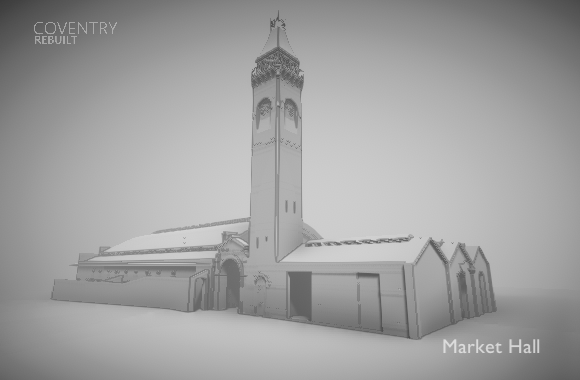
Disaster!
The Coventry Rebuilt Website has suffered a failure and is in the process of being rebuilt. To see the old version see https://web.archive.org/web/20240221053529/http://www.coventryrebuilt.com/
